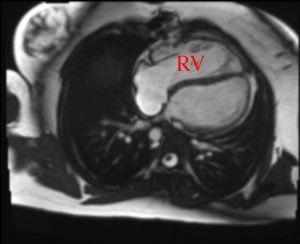MΞDISIM research team of Inria Saclay Ile-de-France jointly with University of Texas Southwestern Medical Center, Dallas, is opening an interdisciplinary PhD position combining cardiac simulations of the heart function with clinical data of patients with congenital heart diseases of the right ventricle (RV).
Stenosis of the pulmonary valve is a relatively common congenital condition taking place either on its own, or within a complex heart disease named “Tetralogy of Fallot”. The initial pressure overload due to the increased level of right ventricle (RV) afterload is corrected surgically by releasing the stenosis. However, this procedure typically disrupts the function of the pulmonary valve, leading to RV volume overload (due to regurgitation through the valve) and RV dilatation. To avoid uncontrolled RV remodeling and possible detrimental effects on the LV – which is known to fail earlier in this cohort of patients than in the normal population – patients need to undergo a pulmonary valve replacement therapy (PVR), the timing of which is crucial for a favorable long-term prognosis.
The aim of the proposed collaborative project is to apply the modeling and data assimilation techniques developed in the MΞDISIM team firstly to characterize the state of both ventricles prior PVR and in the follow-up exams. Secondly, we aim at predicting the outcome of PVR on the function and morphology of the ventricles.
Initially, reduced-order models will be explored [1] and some modifications implemented in order to capture the RV pressure and volume overload, as well as other conditions associated with the clinical state of a given patient [2]. The model will then be made patient-specific by calibration based on clinical indicators obtained from image data (e.g. stroke and end-diastolic volumes, level of valve insufficiency), RV and pulmonary artery pressures (measured during the intervention). The mechanical properties such as contractilities of ventricles — estimated thanks to the model — will be interpreted directly with respect to the patient's clinical condition. Secondly, the left ventricle (LV) and the LV-RV interaction will be taken into consideration via reduced-order models, as well as by employing a complete 3D biomechanical modeling and estimation framework [3]. Finally, physiologically and mechanically based hypotheses about the reverse remodeling of the dilated RV after the PVR will be formulated and assessed vis-a-vis the long-term follow-up of the patients.
This applied PhD topic is suitable for a student with applied mathematics background, good coding skills (Matlab, bases of C++ are an advantage), and highly motivated for an interdisciplinary work between the applied mathematics team and clinical environment of the UT Southwestern Medical Centre in Dallas. The core of the thesis will be in applying the existing “family” of cardiac models developed in MΞDISIM for clinical problems; an implementation of some small modifications linked to the pathology in question; a work with real clinical data using image and signal processing techniques [4]; and the formulation of new continuum mechanics models of the long-term RV remodeling.
During the thesis, regular visits of 1-3 months directly in the Children’s hospital in Dallas (UT Southwestern Medical Centre) will be organized, where the student will participate in the data acquisition sessions, some data processing subtasks specific to the hospital setup, and in the interpretation of modeling results to the clinicians and co-supervisors from the UT Southwestern.
The thesis is expected to start during fall 2017 with a guaranteed 3-year funding.
Supervisors at Inria (contact persons for further information): Dr Radomir Chabiniok, Prof Dominique Chapelle.
Supervisors at UT Southwestern: Dr Animesh Tandon, Prof Tarique Hussain.
More information about the labs on the web sites:
https://m3disim.saclay.inria.fr
http://www.utsouthwestern.edu/labs/pcmri
Figure: Tetralogy of Fallot patient before (left) and after (right) PVR. Note the significantly decreased end-diastolic RV volume after PVR.
Bibliography






